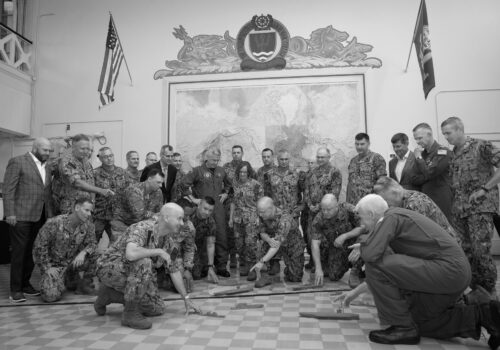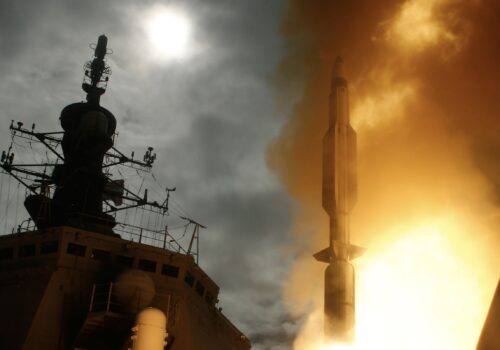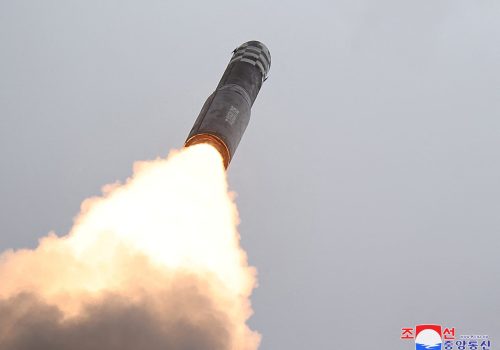Collective security in the Indo-Pacific: Rethinking the United Nations Command
Bottom lines up front
- The Indo-Pacific theater is too large and complex to be managed by a single US command without a collective security counterpart.
- The US-led UN Command in South Korea and Japan provides the means to create a NATO-like structure in the Indo-Pacific.
- Complementary US command-and-control reforms in the Indo-Pacific will provide the necessary focus to deter and, if necessary, fight the three regional adversaries threatening international peace and security.

The international system forged after 1945 is being tested by an increasingly aligned confederation of authoritarian states. For decades, rules and norms upheld global order, but inaction, complacency, and institutional stagnation now threaten their collapse. Authoritarian aggression cannot be appeased—only deterred through credible military power, strong economies, and united diplomacy. The United States cannot shoulder this responsibility alone. The broader free world must strengthen regional defenses and support global collective security. Yet current mechanisms face two flaws: widespread disarmament among free world nations and outdated collective security institutional structures.
The next National Defense Strategy needs to address the seriousness of the situation by resourcing a multi-theater war strategy centered on the Indo-Pacific. This strategy must set the goal of completing the pivot to the Indo-Pacific by the end of the current US administration’s term. Key to completing the pivot will come through implementing a reverse of the Guam doctrine, which will require America’s European allies to take the lead in their own defense. The next defense strategy should avoid the mistake of focusing the pivot only to the west of the international date line.
For the pivot to be successful, the Western Hemisphere must be made more secure—politically, economically, and militarily—by rebooting the Monroe Doctrine to reenable the Organization of American States as an economic security bloc and the reshoring of supply chains to the hemisphere, and to revitalize the Rio Pact to defend the Americas against twenty-first century imperialist coercion and aggression.
Lastly, the next National Defense Strategy must squarely take on the topic of global unified command and implement a winning command and control architecture to ensure the United States military is organized to fight a multi-theater, large-scale war.
The state of collective security
Europe relies on the North Atlantic Treaty Organization (NATO) for its security. NATO, a once-capable alliance, has lapsed, and presently suffers from a diminished martial culture and a state of unpreparedness. NATO relies on Russian weakness rather than allied strength, underscoring its vulnerabilities. More must be done in Europe to strengthen NATO, and, while the United States has a role, most of the heavy lifting must be carried out by Europe because the Indo-Pacific requires much more attention by the United States.
At present, the Indo-Pacific lacks a security system—even one as fragile as NATO. The nexus of China, North Korea, and Russian Far East power poses an increased risk to peace and security across East Asia and the Indian Ocean region and beyond the second island chain of the Western Pacific. American bilateral alliances, along with multilateral security partnerships like the Quadrilateral Security Dialogue (Quad) and Australia-United Kingdom-United States (AUKUS) team, provide cooperative frameworks, strategic alignment, and some deterrence, but they remain fragmented and inadequate against aligned authoritarian strategies.
Historically, the free world attempted collective defense in Asia through the Southeast Asia Treaty Organization (SEATO) and the United Nations Command (UNC). SEATO failed due to its weak regional foundations and colonial baggage. The UNC, however, successfully coordinated international resistance against North Korean aggression and Chinese intervention. Though still operational, UNC was relegated to a diminished support role in 1978 when warfighting responsibilities transitioned to the Republic of Korea—United States Combined Forces Command (CFC).
What the UN Command is, and what it is not
On June 25, 1950, Communist North Korea invaded the United Nations (UN) recognized democratic South Korea. In response, the US president authorized the US Far East Command (FECOM), under General of the Army Douglas MacArthur, to provide material support to the beleaguered South Korean government. The president then directed US forces to intervene in the conflict to repel the invasion. Other nations (the United Kingdom and Australia) also provided forces to assist the Korean government alongside the United States before the UN acted.
The UNC emerged from four key United Nations Security Council Resolutions (UNSCR)—82 through 85—adopted in 1950. These resolutions authorized a US-led unified command to repel North Korean forces and coordinate humanitarian efforts. While the Security Council requested that the United States lead the international response and authorized the unified command to fly the UN flag, the resolutions did not establish UN oversight. The US government retains full executive control, with the UNC still led by a senior US general.
The UNC was established to separate and compartmentalize the aforementioned UNSCR actions in support of the defense of South Korea from unilateral US government actions in East Asia being exercised by FECOM.
The UNC is not a neutral party nor a peacekeeper. It is a belligerent in the Korean conflict, formed to repel North Korean forces, later joined by Chinese forces, that were both being supported by the Soviets.
In 1953, the UNC became a party to the Korean Armistice Agreement with the opposing side’s belligerents, the Korean People’s Army (KPA) of North Korea and the thinly veiled Chinese People’s Volunteers (CPV) of the People’s Republic of China (PRC). As a party to the armistice, the UNC is responsible only for friendly force compliance. The UNC is not responsible for keeping North Korean forces compliant, nor is it a referee between the two Koreas.
The confusion surrounding the UNC stems from its name and authorization to fly the UN flag. Originally embraced as a symbol of global unity, the naming convention reflects post-WWII idealism. In military doctrinal terms, the UNC is a lead nation multinational command. Once dominated exclusively by a US staff, the UNC headquarters expanded to include international staff contributions from the contributing nations—the “sending states”—and maintains an active political apparatus through the resident ambassadors in South Korea.
The UNC also maintains a rear command in Japan, managing designated UN bases under a multinational Status of Forces Agreement (SOFA) with the government of Japan. These bases are critical to future multinational deployments, granting strategic depth and legal protections to non-US UNC forces. Since 2010, the rear command has been led by a multinational officer, reinforcing the UNC’s international character.
While the CFC is now the responsible command for the defense of Korea, the UNC’s role has evolved toward armistice maintenance and multinational integration. Since 2015, revitalization efforts have improved staff capacity and multinational coordination, though more is needed to address the expanding regional threat.
UN Command’s ‘credible legacy’ complements other forces in the region
Given the fractured state of Indo-Pacific security architecture, the region lacks a robust collective defense mechanism. Bilateral alliances and multilateral partnerships like AUKUS and the Quad are insufficient. A future war would be difficult to organize amid crisis. Thus, enhancing an existing structure like the UNC, with its historical legitimacy and multinational foundation, is the pragmatic choice.
The UNC already boasts a credible legacy, a seventeen-nation multilateral presence in Korea and Japan, access to bases, and international agreements to permit military support. These assets make it uniquely positioned to transform the command back into a multinational warfighting headquarters.
The Korean Peninsula has historically served as the competition space and battleground of the great powers. Korea remains the strategic high ground of Northeast Asia, and Northeast Asia is the decisive security and economic terrain for East Asia and the greater Indo-Pacific. Northeast Asia is a position of strength for the free world in the Indo-Pacific, and it should be reinforced as such to maintain it as a strong point—with strategic, operational, and tactical implications for both China and Russia.
Skeptics will argue that the 1950 UNSCRs limit the UNC to the defense of South Korea. Yet UNSCRs 83 and 84 both emphasize the objective to “restore international peace and security to the area.” Korean security is inseparable from broader East Asian stability. With China and North Korea both supporting Russia’s war against Ukraine, the linkages between regional and global conflicts are becoming clearer.
A resumption of hostilities on the Korean Peninsula can be expected to draw in regional powers, including China and Russia—both security treaty allies of North Korea. Moreover, any war in East Asia is likely to involve the Korean Peninsula. South Korea’s strategic location and hosting of sizable US forces make it an unavoidable, even if reluctant, actor in future conflicts.
The UNC’s transformation back into a multinational warfighter does not alter the CFC’s mission and role as the designated alliance warfighter for the defense of South Korea. The UNC would be positioned to martial and organize free world military and humanitarian contributions, ready to intervene and reinforce the CFC to repel authoritarian aggression and return peace and security to the area. A militarily capable UNC would relieve the CFC from managing a wide range of sending-state contributions, allowing each command to focus on specific missions and improve overall 360-degree combat readiness.
Restoring the UNC to its collective security roots would also push necessary reforms in Northeast Asia’s security posture. South Korea and the United States must conclude additional foundational agreements, such as a SOFA (or visiting force agreement), for non-US sending-state forces. Past agreements granting SOFA-like privileges and immunities—such as the 1952 Meyer agreement—must be updated or reaffirmed to ensure legal clarity for free world powers contributing military forces. The UN SOFA with Japan should also be expanded from the nine current signatories to include all seventeen non-US sending states.
In parallel, South Korea needs to continue developing its military’s operational capabilities, completing its obligations under the bilaterally agreed Conditions-based Operational Control Transition Plan (COTP). Doing so best protects South Korean sovereignty in a very dangerous neighborhood, and paves the way for greater Korean leadership within its alliance with the United States and across the region. A more militarily capable and operationally focused UNC would help facilitate this transition by reducing administrative and operations burdens on the CFC.
Returning the UN Command to ‘warfighter status’
One option to seriously consider is to move the UNC’s main headquarters back to Japan (where it resided from 1950-1957), with a small residual forward headquarters in Korea to provide day-to-day oversight over the command’s armistice functions. Stationing the UNC in Japan would better position the command to exercise the designated UN bases and reinvigorate the reception, staging, and onward movement planning and preparations at and through the designated UN bases.
Having the UNC in Japan would catalyze the deployment of free world military forces to the region for training and exercises, a critical function for testing the validity of operational plans and for deterrence. Doing so positions the UNC to become the multinational offshore balancer for the Korean Peninsula, serving as a threat in the strategic calculus of the North Korean regime—and its Chinese and Russian patrons.
Beyond warfighting, the UNC can serve as a framework for broader international cooperation. Nations with limited military capabilities can contribute to non-combat roles, such as humanitarian relief or logistics. Germany’s recent joining of the UNC speaks to the command’s potential to expand beyond countries that were involved in the Korean War.
Returning the UNC to warfighter status and positioning the command in Japan would necessitate internal US force posture reforms. The hard truth is the Indo-Pacific is too large a theater for a single unified command—United States Indo-Pacific Command—to manage in time in space. If the Indo-Pacific was too large a theater for the likes of Nimitz, MacArthur, Slim, and Stilwell to singly manage during World War II, what makes the United States think its current crop of flag officers can handle it from Hawaii? Furthermore, the US force posture in Northeast Asia is divided, duplicative, and too narrowly focused, leaving immense gaps and seams for the authoritarians to exploit.
A consolidated command for Northeast Asia should be considered, merging US Forces Korea and US Forces Japan under a single commander. The consolidated command could be a unified or a sub-unified command. Headquarters consolidation in Northeast Asia would force further conversations within the US Department of Defense to establish additional unified/sub-unified commands to cover the operational flanks in the Southwest Pacific area, South Asia, and the communication zone between the West Coast and the second island chain, similar to how the US military organized itself in WWII.
Finally, a restored, combat-capable UNC would provide strategic flexibility to the free world to meet aggression across the breadth and depth of the Indo-Pacific by serving as a standing multinational unified command. During an East Asian crisis that does not immediately involve the Korean Peninsula—beyond the scope of UNSCR 83-85—the command could reflag under a new multinational banner, exercising collective defense under Article 51 of the UN Charter. In such a situation, the UNC main headquarters in Japan could temporarily transfer its UNSCR 83-85 and armistice responsibilities to the UNC forward headquarters in Korea for the duration of the crisis. In this way, the reflagged UNC staff—already trained and functioning as an operational warfighter—could once again be committed to defeat aggression, if required.
Conclusion
The authoritarians are growing in strength, aligning, and collectively placing increasing pressure on the rules-based international system. The free world must stand up to coercion and aggression. Collective security works but is most effective when it is put in place pre-war. Europe, despite NATO’s major shortcomings, has a reasonably effective collective security mechanism in place. Much work is required to return European military power and NATO to its Cold War status. The Indo-Pacific—the decisive region for the twenty-first century—does not have a multilateral collective security mechanism in place, at least not one that is militarily capable. The next National Defense Strategy must address global unified command and put in place a winning command and control architecture for the Indo-Pacific.
The UNC offers the free world a standing collective security mechanism that can be combat credible, providing peace and security for the free world’s northern flank in the Indo-Pacific. The sobering truth is life is not fair, but it is just. What one sows, one will reap. Those who sow carelessly end up paying the price for wishing away reality. Now is the time to move out on collective security in the Indo-Pacific. The UNC is one option available and returning it to a multinational warfighter should be seriously considered. For those who disagree, forward a better alternative so the free world can realize collective security in the Indo-Pacific and protect the rules-based international system.
About the authors
Richard D. Butler is a retired US Army colonel. His last active duty posting was as the inaugural director for the China Landpower Studies Center, which conducts research, analysis, and education on the rise of China from a military perspective. Originally commissioned in 1995 as a surface warfare officer in the United States Navy, Butler deployed worldwide on multiple destroyers and commanded USS Firebolt (PC 10) during two tours early in the Iraq War. During a joint assignment with III Corps, US Army, he deployed two more times to Iraq as a lead planner. In 2010, he changed his commission to the United States Army, where he performs duties as a strategist. He served in Jerusalem working the two-state solution and has over twelve years of experience in the Indo-Pacific, serving in various capacities as plans chief, strategy chief, and senior strategist at US Army, Pacific; Indo-Pacific Command; and Combined Forces Command.
Shawn P. Creamer is a retired US Army colonel. He served as an infantry officer for thirty years, with more than fourteen years assigned to or directly working on Indo-Pacific security issues, including assignments to US Forces Korea, the ROK/US Combined Forces Command, the United Nations Command, commanding a battalion in Korea and a brigade in Hawaii. He was a US Army War College Fellow with the Massachusetts Institute of Technology’s Security Studies Program. In retirement, Creamer is serving as a fellow with the Institute for Corean-American Studies and as a non-resident senior fellow with the Atlantic Council’s Indo-Pacific Security Initiative and the GeoStrategy Initiative in the Scowcroft Center for Strategy and Security.
The Tiger Project, an Atlantic Council effort, develops new insights and actionable recommendations for the United States, as well as its allies and partners, to deter and counter aggression in the Indo-Pacific. Explore our collection of work, including expert commentary, multimedia content, and in-depth analysis, on strategic defense and deterrence issues in the region.
Related content
Explore the program

The Indo-Pacific Security Initiative (IPSI) informs and shapes the strategies, plans, and policies of the United States and its allies and partners to address the most important rising security challenges in the Indo-Pacific, including China’s growing threat to the international order and North Korea’s destabilizing nuclear weapons advancements. IPSI produces innovative analysis, conducts tabletop exercises, hosts public and private convenings, and engages with US, allied, and partner governments, militaries, media, other key private and public-sector stakeholders, and publics.
Image: South Korean 21st Infantry Division guard post on the Korean Demilitarized Zone by Republic of Korea Army 21st Division



